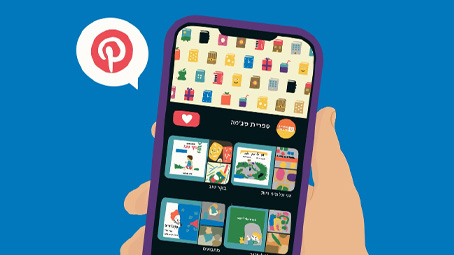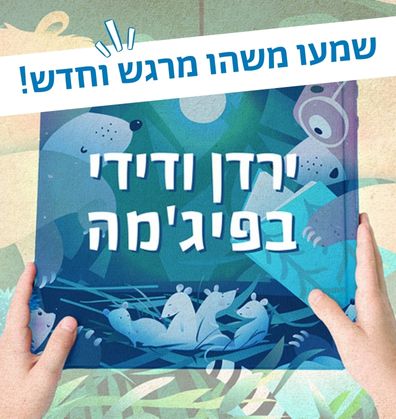כִּשּׁוּרֵי חַיִּים
השבת אבידה
מבוגרים וילדים כאחד, מכירים את תחושות התסכול והעצב העולות כשמשהו "הולך לאיבוד". סיפורים על השבת אבדה מעוררים בנו הזדהות עם מצבים ורגשות המוכרים לנו מחיינו ומהווים פתח למחשבה ולשיח על מצוות חסד המעניקה ערך משמעותי ביחסים שבין אדם לחברו ומשמחת את ליבם של כל הנוגעים בדבר.
סְּפָרִים
Book-Related Family Activities

ללכת לאיבוד
הפחד שילכו לאיבוד מעסיק ילדים רבים. תוכלו לשוחח על כך ולשתף גם בחוויות שלכם כילדים. תוכלו לשאול את הילד או הילדה: האם הלכת פעם לאיבוד או איבדת משהו שהיה יקר לך? איך הרגשת? מה אפשר לעשות כשזה קורה?

המחיזו את הסיפור
תוכלו להמחיז את הסיפור ולהיהפך לרגע לאדם ולנבחן המחפשים זה את זה. אחרי שתמצאו ותתאחדו אחד עם השני, תוכלו להמשיך בהצגה ולדמיין מה יקרה בהמשך, כשהבוקר יעלה.

מציירים ומחפשים
בהשראת האיורים העשירים ציירו יחד ציור משפחתי גדול ומלא בפרטים. לאחר מכן שחקו במשחק חיפושים – בכל פעם מישהו יבחר פרט וכולם יצטרכו לחפש אותו, למשל, “היכן מסתתרת נעל אדומה?”

ממטלה למשחק
גם מטלה יומיומית כמו סידור הבית יכולה להיהפך למשחק מהנה. בהשראת חבריהם של אדם ונבחן הִפכו לסיירת להשבת חפצים אבודים למקומם. כדי להיכנס לאווירה אפשר להכריז ב”מכשיר הקשר” על צעצועים שמחפשים את דרכם למקום.

למה לקרוא עם ילדים שכבר קוראים?
צפו בסרטון מיוחד להורים – למה לקרוא עם ילדים שכבר קוראים?

על הספר
המסע שעוברים הילד אדם וכלבו נבחן בניסיון למצוא זה את זה נוגע ברגשות שילדים רבים יזדהו עימם – החשש לאבד או ללכת לאיבוד, התמודדות עם אובדן, געגוע וקשר עמוק בין אנשים ובעלי חיים.
שתי נקודות המבט בספר משקפות מה עובר על כל אחד מהצדדים, ומסייעות לטפח אמפתיה. הדמויות מצליחות להתמודד עם משבר בעזרת דמיון ובעזרת קהילה תומכת שמיישמת ערכים כמו עזרה לזולת והשבת אבדה.

משוחחים על הספר
שאלות לפני הקריאה
- משמעות שם הספר: “תוכלו לעמוד על ההבדל בין המילה ‘אבד’ למילה ‘עבד’?”
- השערות: “על מה ידבר הספר? אילו רמזים אפשר למצוא בכריכה?”
שאלות מתווכות לאורך הקריאה כדי לסייע לילדים להבין את העלילות המתרחשות במקביל, לדוגמה:
- בסוף העמוד שבו הכלבים יוצאים לחיפושים: “מה קורה בזמן שהכלבים מחפשים את אדם?”
שאלות לשיחה בעקבות מפגשים חוזרים עם הספר:
- איך לדעתכם הרגיש אדם כשלא מצא את נבחן? אילו מחשבות עברו לו בראש לדעתכם?
- איך הרגיש נבחן כשלא מצא את אדם?
- מה עזר להם להתמודד עם המצב?
- קרה לכם פעם שהלכתם לאיבוד או שמישהו או משהו יקר לכם הלך לאיבוד? איך הרגשתם?
- למה לדעתכם הילדים והכלבים הצטרפו לחיפושים?
- איך הרגישו אדם ונבחן כשעזרו להם?
התייחסות לעמודים שבהם אדם ונבחן מדמיינים זה את קורותיו של זה
- מה רואים באיורים? האם כל הדברים האלו התרחשו באמת?
- למה לדעתכם אדם ונבחן מדמיינים את זה?
- מה אתם הייתם מדמיינים?
- איך דמיון יכול לעזור לנו ברגעים קשים?

העולם דרך עיניים של בעל חיים
נקודת מבטו של נבחן יכולה להוות השראה להתנסות משעשעת בכיתה. אפשר להקרין או להראות תמונות של חיות במצבים שונים – למשל חתול שרודף אחרי הזנב של עצמו (ברשת רצים הרבה סרטוני חיות מצחיקים) – ולהזמין את הילדים לנסות לדמיין מה בעל החיים חושב או מה היה אומר לו היה מדבר.

להתמצא בסביבה
תוכלו לקיים מערך שיעורים בנוגע לתפיסה מרחבית של הסביבה הקרובה:
1. הקרינו על מסך את סביבת בית הספר כפי שהיא נראית במפת גוגל, או שרטטו את מפת בית הספר. אפשר לעבור על שמות הרחובות הסמוכים, ולהזמין את הילדים להצביע על המסלול מהבית שלהם עד לבית הספר. לאחר מכן אפשר לעבור לתצוגת סטריט ויו ו”לשוטט” בסביבת בית הספר.
2. חלקו את הכיתה לקבוצות קטנות, שכל אחת מהן תכין דגם או ציור של השכונה או סביבת בית הספר. גם אפשר לחלק למקטעים ולחבר הכול לדגם משותף.

מה זה "במקביל"
הכותבת נוקטת טכניקה של שתי עלילות המתרחשות בו בזמן. כדאי להמחיש את המושג “במקביל”, ולהזמין את הילדים לשלב אותו במשפטים.
תוכלו להיעזר בשיר “זה מה שקרה” מתוך הסדרה “ילדי בית העץ”, המביא כמה נקודות מבט על אירוע מסוים.
הספר מציג תמונת ראי – אדם ונבחן עושים את אותם הדברים. תוכלו לקיים משחק שבו בכל תור שני ילדים עומדים זה מול זה ועושים את אותן התנועות; או לשחק ב”מלך התנועות”, שבו ילד אחד מתנדב לצאת מהכיתה, שאר הילדים בוחרים מלך שכולם מחקים את תנועותיו, וכשהילד חוזר עליו לנחש מי מלך התנועות.

חיות המחמד שלנו
בקשו מההורים לשלוח סרטונים ותמונות של חיות המחמד של המשפחה (אם אין בבית אפשר לבקש של מישהו מהמשפחה המורחבת או מהשכנים). תוכלו לערוך בכיתה חידון זיהוי או להזמין את הילדים לספר על חיות הבית שלהם.
הילדים יוכלו לכתוב טקסט קצר על חיית המחמד שלהם ולצרף לתמונה, ולאחר מכן תכינו בכיתה קיר “חיות הבית שלנו”.

לוח מודעות של כיתה א'1
הכינו לכיתה לוח מודעות.
דמיינו שאיבדתם משהו חשוב או אהוב – צעצוע, תיק, חיית מחמד או אפילו ספר!
כמו בספר “אבד כלבלב”, עכשיו תורכם לכתוב מודעה שתעזור לכם למצוא את האבדה.
הוראות לכתיבת מודעה קצרה וברורה שתעזור לאנשים להבין:
- מה איבדתם (מה זה ואיך זה נראה – צבעים, גודל, מרקם וכדומה).
- איפה איבדתם (רחוב, מקום, גן וכדומה).
- מתי זה קרה (יום, שעה בערך).
- מה מיוחד באבדה (למה היא חשובה לכם).
- מה על המוצא לעשות (למי עליו לפנות, איך הוא יכול לעזור).
אפשר להוסיף ציור של האבדה כדי שהמודעה תהיה ברורה ומושכת את העין.
טיפ:
התחילו במילים כמו “אבד לי…”; “נעלם לי…” וסיימו במילים: “אם מצאתם, בבקשה…“

העשרה לשונית - אומר מילים ומיומנויות השוואה
הסיפור כתוב בשפה עשירה, וזו הזדמנות נהדרת להתעכב על מילים כמו “חוטמו”, “הצטיידו”, “דלועים”, “קולר” ועוד.
אפשר להתייחס למילים הללו תוך כדי קריאה, ואחר כך להכין חידון – מילה ופירושה; או משחק זיכרון – מילה וציור.
הסיפור גם מזמן לשפר מיומנות השוואה:
מה דומה ושונה בין המודעות, בין המקומות שעליהם חשבו הילד והכלב ובין אופני החיפוש.

בית מארח
מחפשים רעיון לבית מארח? אפשר בפיג’מה!
בקשו מהילדים להביא את העותק האישי שלהם מהבית, והתחילו את הפעילות כשכל ילד וילדה מחזיקים בעותק שלהם לזמן קריאה משותף. הילדים יכולים לחלק את העמודים ביניהם ולקרוא בעצמם, או שאתם תקראו יחד איתם. בשיח שלאחר הקריאה מומלץ להיעזר בשאלות המוצעות בסוף הספר וגם בהצעות לצוותים.
מפת דרכים
כל ילד יצייר את הדרך שעשה מהמקום שממנו הגיע. המפה לא צריכה להיות מדויקת, ואפשר להציע לילדים להוסיף לה ציוני דרך, כגון עצים, מכולת, גן שעשועים. הילדים יוכלו להציג את סיפור הדרך שלהם בעזרת המפה.
חידון חיפושים
החביאו במרחב הבית בובות של בעלי חיים כמספר הילדים. בכל פעם תקראו לילדים חידה שרומזת למיקום, למשל: “חפשו בעלי חיים פרוותי במקום שבו עולים ריחות בישולים ועוגות במגירה הנמוכה ביותר”. הילדים יתייעצו באופן קבוצתי על פתרון החידה, ואחרי שיחליטו על מקום אפשרי ישלחו נציג אחד למצוא את המבוקש.
מבוך רצפה
שרטטו על הרצפה מסלול פשוט בעזרת נייר דבק, סרט בד דק או חוט צמר. בכל פעם אחד המשתתפים “ילך לאיבוד” בעזרת כיסוי עיניים וכמה סיבובים במקום. שאר חברי הקבוצה (או מישהו אחד בכל פעם) יצטרכו לכוון אותו ליציאה בעזרת הנחיות בלבד, בלי לדרוך על קווי המסלול.

Family Reading Advice
There are lots of ways to enjoy a book – after reading it, you can go back and “read the illustrations”: Which objects can you identify? And which plants?

Every Excursion has its Own Story
You can discuss with your children and remember family trips together – Where did you travel? Did anyone get upset on the trip and you helped them? Do you also have a story about an item that got lost while you were on a trip? Or perhaps you also helped to protect the environment?

Searching in the Water
This book can inspire you to play an entertaining quest – fill a large bowl or bucket with water, then add soap so that the water will not be clear and transparent. Now slip in all sorts of small objects: A teaspoon, bottlecap, pebble, coin, or any other item. Ask your children to help you find the “lost” items in the water.

What is it like to have Blurred vision?
If you wear glasses, you know how it feels. Now you can let the rest of your family experience what it feels like: Place baking paper or a thin, light-colored fabric on your eyes, and try to see through it. Look around and at one another – what is different? How do you feel?

With an open heart
Following Yonatan, you can discuss and share: What can be the meaning of the phrase: “to open up your heart”? Is there an image or item that reminds you of loved ones, and make you feel like your heart is opening up and your feelings are welling up?
QR code
Would you like to listen to The Key to My Heart? Scan the code and you can listen to this book together

Where have I been and what have I been up to?
Thanks to the lost keys, Yonatan gets a glimpse into his father’s daily routine. And what did you do today? You can play charades, miming to one another a place you have visited or something you have done. Take turns acting out a place or action, while the rest of your family tries to guess where you have been and what you have been up to.

Details in the illustrations
Yossi Abulafia’s illustrations are full of details. You may want to stop and look: Which animals can you find in the illustrations? Do they appear more than once? What are the people on the street up to? And now, look at the illustrations again: Have you discovered anything that you did not seen the first time?
A discussion on what has been lost
Have you ever lost anything you found important? How did you feel and what did you do? Perhaps you’ve found someone else’s lost item… This book invites children as well as parents to share their childhood experiences of losing and finding lost items.
A video about a lost and found stand
A video about a lost and found stand
Shabi and Uzza from the Israeli children’s television show Parpar Nechmad are also returning lost items to their owners. Scan the code to watch the video.
A discussion on searching and finding
Following this book, you may want to embark on searches together with your parents, grandparents, or other relatives: What have you found? Were you surprised? Do you enjoy searching and finding?
A game of Search Cootie Catcher
A game for both seekers and finders.
Scan the QR code
Print out, cut out and fold according to the instructions.
Have you searched? Have you found? Would you like to play again?
Illustrations
This book contains both colorful and black and white illustrations. Can you figure out when the illustrations are in black and white, and when they are multicolored?
A game of “what’s missing?”
A game of “what’s missing?”
Place several items in a row and look closely.
Take turns hiding one of the items while the rest of your family members have their eyes closed. Once it has been removed and hidden, the other players can open their eyes and start searching – Which item is now missing? Where was it hidden?
Pleased to meet you, I’m Hyla!
I’m similar to a frog but smaller. I can be found in Israel, mostly on trees, eating insects and laying eggs in the water. I’m a protected species and therefore cannot be kept in a jar, only in nature.
Ayin Hillel (1926–1990)
Ayin Hill (Hillel Omer) was born in Kibbutz Mishmar HaEmek in 1926. An author, poet, and landscape architect, Ayin Hillel often incorporated nature, landscapes, and animals into his poems. Many generations of Israeli children were raised on his literary gems, such as the Uncle Simcha stories, Why does the Zebra Wear Pajamas?, Yossi, Smart Child of Mine, and many others. Ayin Hillel also wrote poetry and prose for adults. He won many awards for his work, and passed away in 1990.
Proposed Family Activities:
- Rabbit’s tail appears in every illustration, but Rabbit cannot find it. You may want to ask your child to leaf through the book, and locate the tail on each page.
- You could attach a kerchief to the back of your child’s pants, and go searching for their tail around the house: Where is that tail hiding? Perhaps you could follow the route described in the book: under the bed, inside the shoes, under the pillow, in the kitchen, then the bathroom, and finally sit down. Like the rabbit in the story, your child can leap for joy when their lost tail is finally found.
- Can your child name their body parts? You may enjoy playing a game in which you ask your child: Where’s your elbow? Where’s your knee? Where’s your big toe? And have them point to each body part in turn.
- Rabbit looks in the bathroom and catches his reflection in the mirror. You may also want to stand in front of the mirror with your child, name one of the emotions felt by Rabbit throughout the book, and make the corresponding facial expression: smile to show joy, make a concerned face, get excited, and so on.
- Who has a tail? Perhaps you could take out some stuffed animals or look through a picture-book to discover what other animal has a tail. Which has long ears? What other animal can leap and jump?
delicious carrot cake
- What does Rabbit like to eat? Carrots, of course! How about making a delicious carrot cake together?
Ingredients:
2 eggs
½ a cup of sugar
1/3 cup of oil
2 medium-sized carrots, grated
1 cup self-raising flour (or 1 cup of white flour mixed with a teaspoon of baking powder)
½ a teaspoon of baking soda
1 flat teaspoon of cinnamon
Method:
- Preheat the oven to 180 degrees
- Mix all the ingredients in the order in which they appear
- Put the batter in an oiled baking pan, and bake for 20-25 minutes. Insert a toothpick into the cake, and when it comes out dry, the cake is ready
- Sit in the kitchen, eat the cake together, hug each other, and enjoy
Family Activities:
1. Noa is very attached to the old doll that her grandmother made for her, but also likes new dolls and toys. You can ask your children which dolls and toys they like in particular, and remind them who gave them the gifts and under which circumstances.
2. Mr. Minasa tried to get rid of his old shoes when he arrived in the new country. You can play an imaginary game with your children: If you were leaving for a faraway place, what would you take with you and what would you leave behind?
3. Like Grandmother Agarnesh, you too can craft a hand-made doll for your child, using old socks and clothing. You are invited to send us a photograph of the doll, which we will happily post on the Sifriyat Pijama website!
4. Mr. Minasa arrived in the new country from Ethiopia. Where did your family originate? This is an opportunity to share your personal immigrant story with your children, and show them photographs of the old country. Perhaps you too have old bjects or clothing that you can search for together.
5. Mr. Minasa’s neighbors recognized his old shoes and returned them to him. Did you ever find something and return it to its owner? Was the owner happy to receive the lost object?
6. You can act out the story with your children. Each one in turn takes on the role of Mr. Minasa and looks for places around the house to hide the shoes. The other player finds them and declares, “Oh, here are Mr. Minasa’s old shoes!”
“The Stone of Claims”
The Sages taught: There was a stone of claims in Jerusalem, and anyone who lost an item would be directed there, and anyone who found a lost item would be directed there. (Talmud Bavli, Bava Metzia, 28b).
One family member is the “finder”, who stands on the stone of claims, and describes an item in the home in great detail. Whoever guesses what the item is, brings it to the claimant, and becomes the next one.

Hashavat Aveda – returning lost property to its owner
Have you ever lost anything that belong to you or others like Itamar did? How did you feel when you discovered that the item was missing? Have you helped others look for something that they lost? How does it feel to find something that someone else lost? What can we do when that happens?

An Illustrative Journey
The book’s illustrations reveal details about life in Eretz Yisrael thousands of years ago. You can focus on a different detail each time, such as the stone houses, utensils, or animals; you can ask questions and try to imagine what it was like to be a shepherd in the field, and what sound the bells on the High Priest’s robe made.
Where is the bell hiding?
You can hide a bell or similar item around the house, and send your entire family searching for it. The finder will be the next hider. And what if it’s hard to find? You can ask the hider to give you hints by making sounds (such as “ding dong”). As the seekers get closer to the hiding place, the hider will make the bell sounds louder.
Family Activities
- You may want to look at the lovely illustrations by Menachem Halberstadt together, and ask your child to tell the story in their own words. We do not know what Rabbi Hanina Ben Dossa looked like, but we can imagine the lifestyle of his time and the Galilean landscape. Perhaps you would enjoy searching for clues about his time and place in the illustrations.
- Menachem Halberstadt added amusing details in his illustrations that are not mentioned in the text. You may want to look for the illustration of all the chickens in the yard. What are they doing? Did you find anything about this illustration funny?
- In the story, Rabbi Hanina describes the rooster and hen using signs: the rooster was black with a white spot, and the hen was white with gold dots. You may want to play the guessing game: one of you thinks of an object in the room and describes it using signs, and the other has to guess which object it is. Did you guess right?
- Have you or your child ever lost something dear? Was it found? Try to recall together the feeling you had when you discovered the item had been lost, or found.
- How can we refrain from losing things we hold dear? You may want to let your child think of ideas to help them keep track of their property, and share some of your techniques and practices with them. You may also like to teach your child where items found are taken today (for instance the police station, or the “lost and found” in public places).
- Perhaps you would enjoy playing “Where’s the lost chicken?”: place the palm of your hand on a sheet of paper so your thumb is separate from the other fingers. Draw around your hand – the thumb will be the chicken’s head, and the fingers will be its wings. Add feet, a cockscomb and beak, and cut out the chicken. One of the participants hides the chicken, and the others have to find it. The one who hid it can help the others find the lost chicken by saying “hot” or “cold” as they get nearer and further away from its hiding place.
Who was Rabbi Hanina Ben Dossa?
Rabbi Hanina Ben Dossa was a Tanna – a scholar from the time of the Mishna – who lived in the Galilee some 2000 years ago. He was an incredible man, and many tales are told of his modesty and special qualities. Although Rabbi Hanina and his family lived in extreme poverty, he was not tempted to take anything that did not belong to him, and was very careful about returning any lost property to its rightful owners. The writer Ori Elon based his adaptation of the story of Rabbi Hanina and the lost rooster and hen on the following short story found in the Talmud, in the Tractate of Taanit, page 25a:
Once it happened that a man passed by Rabbi Hanina’s house and left hens there and the wife of Rabbi Hanina Ben Dossa found them. Her husband, however, forbade her to eat of their eggs. As the eggs and the chickens increased in number he was very troubled by them and he therefore sold them and with the proceeds he purchased goats. One day the man who lost the hens passed by [the house] again and said to his companion: “Here I left my hens”. Rabbi Hanina overhearing this asked him: “Have you any sign [by which to identify them]?” He replied: “Yes”. He gave him the sign and took away the goats.
Family Activities
- Throughout the book, illustrator Liora Grossman has depicted each of the objects lost by the characters in the story. You may want to look through it together, and search for all the missing items. Have you found them all? Have you ever looked for something and realized it was hiding “right under your nose”?
- Page by page, Aviv meets a tractor, princess, cloud and clown that claim “It’s mine!”, but none give all the signs describing the ball that he had found. You may want to play a similar guessing game: one player closes their eyes, while the other chooses a small object, hides it behind their back, and describes it using some identifying features. The first player then opens their eyes and tries to guess which object is being described and concealed.
- How can we refrain from losing things that are important to us? Ask your child to offer some ideas about how to take care of their property, and share some tips with them on how you make sure you don’t lose yours.
- Have you or your child ever lost something you loved? How did you feel? Have you found a lost object? Perhaps you too will have the privilege of returning it to its rightful owner! You may want to make a ‘lost object’ poster with a description of what you have found, along with your telephone number. You could go out on the street together and put the poster up in a public place. If anyone calls, don’t forget to ask them for signs to make sure you indeed return the object to its rightful owner.
- At the end of the story, Aviv and Yuval play ball together. You too can to play ball – passing it to one another, trying to shoot hoops, or kicking it toward the goal… just make sure you don’t lose it!

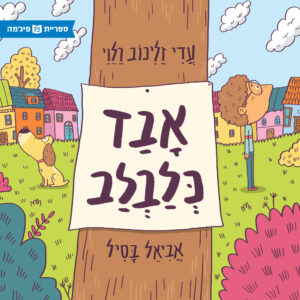 Lost Puppy
Lost Puppy 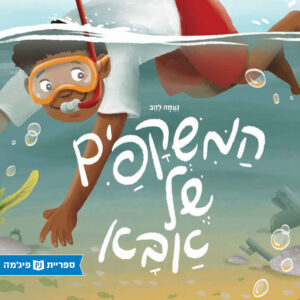 Aba’s Glasses
Aba’s Glasses  The Key to My Heart
The Key to My Heart  Found
Found  I Like to Look For…
I Like to Look For…  A Tale of a Rabbit and a Tail
A Tale of a Rabbit and a Tail  An Old Pair of Shoes
An Old Pair of Shoes 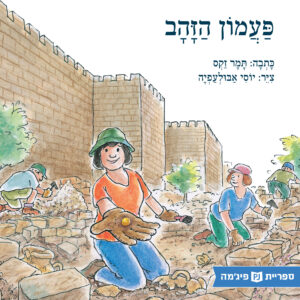 The Golden Bell
The Golden Bell  The Chickens Who Became Goats
The Chickens Who Became Goats  It’s Mine
It’s Mine  הַמְחָזָה
הַמְחָזָה